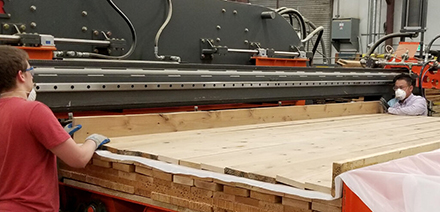
Matthew Clark and Hui Li produce CLT panels with thermally-modified wood at the Research and Technology Park at WSU
Washington State University researchers have received a two-year grant to make more resilient and durable housing materials from thermally-modified cross laminated timber (CLT) and recycled carbon fibre. Source: Timberbiz
The researchers, including Pouria Bahmani, assistant professor and Karl Englund, research professor in the Department of Civil and Environmental Engineering, along with Hui Li, assistant research professor in the Composite Materials & Engineering Centre, are collaborating with Composite Recycling Technology Centre (CRTC) in Port Angeles and Construction Engineering Research Laboratory to explore ways to use advanced thermally-modified CLT material in deployable structures, with a goal of extending its application to single and two-storey residential buildings.
As part of the project, the researchers will analyse the structure and materials and evaluate the possibility of mass-producing these panels, a one-of-a-kind initiative in the Pacific Northwest.
“One primary objective of this project is to develop methods for connecting the panels together, facilitating the construction of modular and deployable structures,” Bahmani said. “We utilize steel connections and will conduct thorough testing to ensure the safety and durability of these structures.”
CLT is an engineered wood product typically used for construction. It consists of layers of wood boards stacked in alternating directions and bonded together with structural adhesives. This cross-lamination technique enhances the strength and stability of the timber panels, allowing them to bear heavy loads and resist deformation.
Testing thermally-modified wood lumber at the PACCAR structural laboratory at WSU.
CLT is renowned for its sustainability, as it is often made from fast-growing trees. It offers several advantages over traditional construction materials, including faster construction times, reduced environmental impact, and excellent thermal properties. The wood product has gained popularity worldwide as a versatile and eco-friendly alternative to concrete, steel, and other conventional building materials. Because it’s lightweight compared to other construction materials, using CLT in modular construction and building projects can also save energy during transportation.
The CRTC has been developing advanced CLT timber that uses thermally modified western hemlock in its formulation. Thermal modification makes the wood more resistant to decay and increases its durability.
The researchers have been working to strengthen the thermally modified wood by adding repurposed carbon fibre composites to the CLT panels. Carbon fibre composite materials are used in many modern products, from aircraft parts to wind turbine blades to fishing rods.
“We are currently focused on exploring the thermal modification process for western hemlock species to create modular, durable, and deployable structures constructed from thermally treated CLT panels,” he said.





